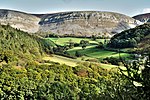Llanelidan

Llanelidan is a small village and community in the county of Denbighshire in north-east Wales. The community also includes the hamlet of Rhyd-y-Meudwy. The church, village hall and pub all lie within 200 yards of each other overlooking the village cricket ground and pavilion. Also in the village centre is King George's field, this is land legally protected by the Fields in Trust Charity, and is free for use by anyone. Public space in the village includes the Village Green. This is 3 1/2 acres of registered Village Green Denbighshire Commons Register No. VG12 Ancient and semi natural woodland that is a bluebell wood in the spring. It was allotted to be held IN TRUST for the Community of Llanelidan by the Inclosure Awards of 1861 and is for the enjoyment and recreation of members of the Parish. It lies north west of the village along a footpath towards Coed Pen Y Bryn. Reference ; Public Record Office MAF 1/243 EXMID 13430 and Map date 1816 found at RRO EXMID 15388 Denbigh Record Office QSD/DE/5
Excerpt from the Wikipedia article Llanelidan (License: CC BY-SA 3.0, Authors, Images).Llanelidan
B5429,
Geographical coordinates (GPS) Address Nearby Places Show on map
Geographical coordinates (GPS)
| Latitude | Longitude |
|---|---|
| N 53.043 ° | E -3.333 ° |
Address
Capel Carmel
B5429
LL15 2PU , Llanelidan
Wales, United Kingdom
Open on Google Maps






